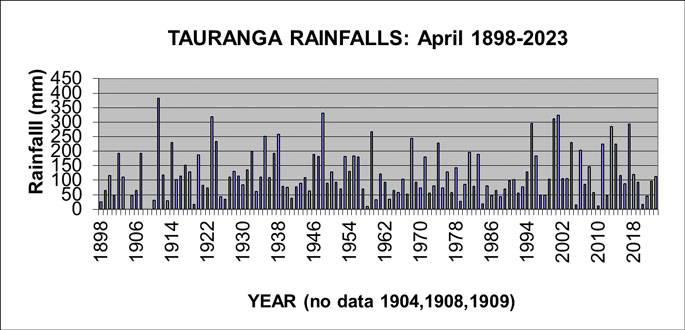 |
Weather Eye with John Maunder |
Monthly rainfalls for Tauranga have been recorded at several recording sites during the last 126 years.
From January 1898 to December 1904, the observation site was described as the Tauranga Harbour, from November 1904 to April 1907 the site was described as simply ‘Tauranga'.
From January 1910 to December 1923 the site was Waikareao, in Otumoetai; from January 1924 to September 1940 the site was at 148 Waihi Rd, in Judea; from October 1940 to January 1941 the site was at Te Puna; and from February 1941 to now, the site is Tauranga Airport.
The methodology used in adjusting the older sites to the current observing site was published in the ‘NZ Meteorological Service Miscellaneous Publication' No 180.
It is considered that the homogeneous rainfall series described here is a fair and true record of what the rainfall would have been if the current observation site (Tauranga Airport) had been used since 1898.
This should be coupled with the understanding that although standard accepted methodologies have been used, any adjustments are only estimates of what would have occurred if the location of the rainfall records had always been in the same place with the same surroundings and the same or similar recording gauge.
In terms of climate change (such as is it getting wetter or drier, or warmer or colder), the methodology used in computing an ‘official' set of climate observations is very important, as otherwise erroneous conclusions may be drawn.
April 2023 had a rainfall of 112.2 mm.
The graph shows the range of rainfalls from a high of 383 mm in 1911 to a low of 10 mm in 1958.

The second wettest April was 1948, when 333 mm was recorded; and the second driest was April 2010 with only 12 mm.
The long-term average rainfall for Tauranga for April is 120 mm.
Since 1898, there have been 11 April months with a rainfall of 250 mm or more.
In chronological order, the wettest April months are: 1911, 1923, 1935, 1938, 1948, 1959, 1995, 2000, 2001, 2013, and 2017.
In terms of dry April months, there have been ten months with rainfall of 30 mm or less.
In chronological order, the driest April months are: 1898, 1910, 1913, 1919, 1958, 1979, 1984, 2005, 2010 and 2020.
***************
Temperatures have been recorded in the Tauranga area at several sites during the last 110 years, including the current Tauranga Airport site from June 1990.
It's very common for areas such as Tauranga to have had different observation sites during the years – and the readings from the earlier sites have been adjusted to the present site using standard climatological procedures.
The temperature series, as shown in the graph, are based on the data from the original observations from the various sites as available on the NIWA National Climate Database archive, with data from the sites prior to the Tauranga Airport site being adjusted, where appropriate, to temperatures which are likely to have been recorded at the current airport site.
Traditionally, temperature observations have been recorded with a set of maximum and minimum temperature thermometers.
These record the daily maximum temperature (usually recorded in mid-afternoon), and the daily minimum temperature (usually recorded just before dawn).
The graph shows details of the average daily maximum temperatures (called simply ‘afternoon'), for Tauranga for April from 1913-2023. Note April 1947 and 1964 are not included because of incomplete data.

The long-term average afternoon temperature in April for Tauranga for is 20.0 degrees Celsius, ranging from the "cool" April months of 1925, with an average afternoon temperature of 18.2 degrees Celsius, and 1923 with an average afternoon temperature of 18.3 degrees Celsius, to the "warm" April months of 1938 (22.2 degrees Celsius), and 1916 (22.1 degrees Celsius).
The graph of the average afternoon temperatures for April shows generally normal variations from April to April, but several recent April months have been a little warmer than other April months.
From 1913 to 2023, there have been 19 April months with an average afternoon temperature of 21.0 degrees Celsius or more, and eight April months with an average afternoon temperature of less than 19.0 degrees Celsius.
The value for April 2023 was 21.1 degrees Celsius.
The eighth warmest April months – in terms of afternoon temperatures – on record, in chronological order, are 1916, 1928, 1938, 2012, 2013, 2014, 2016, and 2022. The average afternoon temperatures for Tauranga for the 50 years 1914-1962, and the 50-year period 1963-2011 are both 20.0 degrees Celsius.
For further information, email john.maunder@gmail.com

